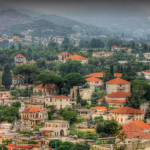For twelve years I cried for my lost friends and fellow military members, but I also cried for the children, the women, and the men of Iraq maimed or killed in the violence. Lives lost and lives never really lived. I began to see the effect on the country: a fractured society in a broken world, and me, broken as well. My presence in the country meant I played a part in harming innocent people. I began to comprehend the magnitude of the destruction the US military caused in Iraq. And yet I could not see, in the broken, asymmetrical pieces, the Creator’s inexorable hand guiding me to deeper understanding. Yes, there was great pain, and yes, in my finite understanding, I could not see how broken pieces could be realigned and mended, for after all, even the rebuilt structure is not the same as the one that was destroyed, no matter how closely the architect follows the old design. But that is where the truly miraculous happened for me. Rather than avoid the shame I carried and the pain of the memories of trauma and loss, I came to see them as powerful teachers. I know that the US invasion and occupation produced unimaginable grief and loss for many in Iraq. Almost daily I reflected on the fact that at the end of my military service, I returned to a stable, secure nation with an intact, extensive infrastructure. Millions were forced to live their lives in a violent and unstable region through no choice of their own while some in my homeland regarded me as a hero. I pondered the legacy of the US military in the region. I do not think to compare my experience as a foreign military member to the grief and loss of those in Iraq. I recognize that the suffering has been much, and I have experienced little in comparison to the families and communities in Iraq. Today, I observe the life that has been rebuilt for me. I think of the wise words that tell me that we have no peace, that much of the sickness in the world is because we forget that we belong to each other. Kinship happens when we refuse to forget that truth. I have a group of veteran friends who are dedicated to the work of bearing witness to the impact of the US military in foreign countries--Iraq, Afghanistan, Viet Nam, and more. I have a group of Iraqi friends in Philadelphia. I am very fortunate to sit with them in celebrating their Arab culture, sitting with them in remembrance of their lives in their ancestral homeland, and sharing in the joy of our new life. We raised money, started two bee colonies of our own, and donated the honey they produced. We volunteer together. The strength and resilience of my friends whose families still rebuild their nation or rebuild lives in other countries simply produces awe. God’s design is seen in beauty and symmetry in the natural world, and people can produce amazing architectural feats when meditating on this beauty and design, but I am beginning to understand how God is revealed in the asymmetry, in the rubble, in the incomprehensible. These phenomena have taught me that peace comes through seeing God in pain. The rubble I now see is the walls that I had built and life broke down: the walls of judgment and criticism, the walls separating me from others based on differences in background and culture, and the walls that told me the pain and the loss of my military friends was different and distinct than the pain and loss of Iraqis. I better understand how we belong to each other. When I come to accept the pain rather than avoid or deny it, it instructs me in peace. By reflecting peace and joy with these friends, we bring the sweetness of the honeycomb, the joy of the fruit tree, and the profundity of the Arabesque into this life.
By: Leroy Enck






